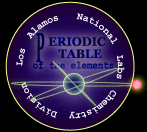

| Atomic Number: | 98 |
Atomic Radius: | ~186 pm | ||
| Atomic Symbol: | Cf |
Melting Point: | 860 �C | ||
| Atomic Weight: | 251 |
Boiling Point: | -- | ||
| Electron Configuration: | [Rn]7s25f10 | Oxidation States: | 3 |
(State and University of California) Californium, the sixth transuranium element to be discovered, was produced by Thompson, Street, Ghioirso, and Seaborg in 1950 by bombarding microgram quantities of 242Cm with 35 MeV helium ions in the Berkeley 60-inch cyclotron. Californium (III) is the only ion stable in aqueous solutions, all attempts to reduce or oxidize californium (III) having failed. The isotope 249Cf results from the beta decay of 249Bk while the heavier isotopes are produced by intense neutron irradiation by the reactions. The existence of the isotopes 249Cf, 250Cf, 251Cf, and 252Cf makes it feasible to isolate californium in weighable amounts so that its properties can be investigated with macroscopic quantities.
Properties
Californium-252 is a very strong neutron emitter. One microgram releases 170 million neutrons per minute, which presents biological hazards. Proper safeguards should be used in handling californium. Reduction of californium to its metallic state has not yet been accomplished. Because californium is a very efficient source of neutrons, many new uses are expected for it. It has already found use in neutron moisture gauges and in well-logging (the determination of water and oil-bearing layers). It is also being used as a portable neutron source for discovery of metals such as gold or silver by on-the-spot activation analysis. 252Cf is now being offered for sale by the O.R.N.L. at a cost of $10/mg. As of May, 1975, more than 63 mg have been produced and sold. It has been suggested that californium may be produced in certain stellar explosions, called supernovae, for the radioactive decay of 254Cf (55-day half-life) agrees with the characteristics of the light curves of such explosions observed through telescopes. This suggestion, however, is questioned.
Title Picture: California

Sources: CRC Handbook of Chemistry and Physics and the American Chemical Society.
Last Updated: 12/15/2003,� Chemistry Operations
Operated by the University
of California for the US Department
of Energy
|
Help
| Copyright � UC 2003 | Disclaimer